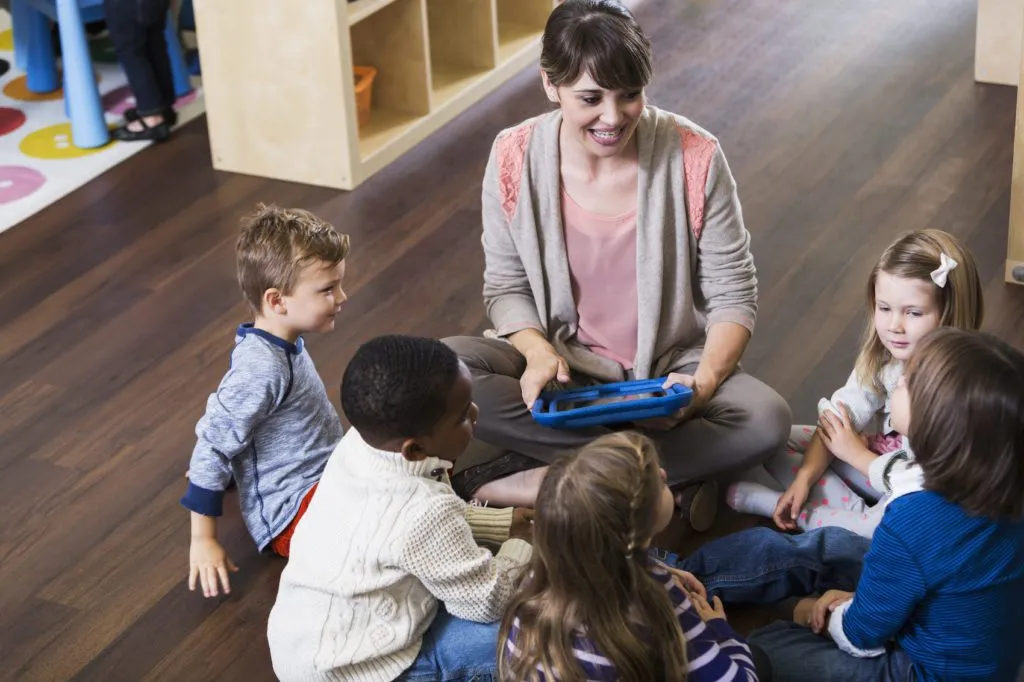Why I Don’t Tell Children to “Use Your Words” Anymore


Lily and Ben, both of whom are about to turn three years old, work alongside each other using mortars and pestles to grind lavender and chamomile flowers which they select from a shared bowl in the center of the table. The sweet, floral fragrance fills the Discovery area as both children tinker with and grind the flowers. All is serene, self-directed, and focused—at least for a few brief minutes.
Then, Tyler enters the Discovery area. Tyler eagerly reaches for the shared bowl of lavender flowers, dumps some on the table, and picks up a pestle that Ben set down for a moment—cue the charged emotions. The children who were initially working in the Discovery area with the lavender—Lily and Ben— grab the bowl and squeal with scowls on their faces as a back-and-forth tug-of-war over the lavender bowl ensues. Tyler reaches for the spilled lavender flowers, throws them on the ground, and begins to cry. Lily and Ben also begin to cry. A concerned teacher swoops in, steadies the bowl, and exclaims, “What is going on over here? Use your words!” All three children stare blankly back at the teacher and continue to cry.
 Does this type of scenario sound familiar? As children learn to navigate social interactions and peer relationships, conflict and strong emotional responses are going to happen. The phrase “use your words” has crept its way into many well-intentioned early childhood settings, yet it offers little support and guidance for young children who are experiencing strong emotions such as anger, frustration, and sadness.
Does this type of scenario sound familiar? As children learn to navigate social interactions and peer relationships, conflict and strong emotional responses are going to happen. The phrase “use your words” has crept its way into many well-intentioned early childhood settings, yet it offers little support and guidance for young children who are experiencing strong emotions such as anger, frustration, and sadness.
Even to me as an adult, the phrase “Use your words!” feels confusing and disconnected. Which words am I supposed to use? What is the right answer here? If I am experiencing a stressful situation, such as a long exhausting day at work or a disagreement with a friend, I seek to feel seen and heard, not prodded and badgered. The same goes for young children.
Perhaps one of the most challenging things to do as an early childhood educator is to remain calm, cool, and collected when children are not. The ability to develop composed and confident responses to children in the heat of the moment takes practice, patience, and self-awareness.
When supporting children to manage strong emotions and process their responses, the goal is not to stop the emotion or end the disagreement as soon as possible. Rather, we are striving to help children identify and manage their responses in positive ways.
Think about this question: what is most helpful to children when they are faced with an emotionally charged situation? Rather than urging children to “use their words,“ consider trying the following 4 strategies that both model and teach social–emotional skills that essentially empower children to communicate their thoughts and feelings.
- Pause
You may need a moment to pause and process the situation. Often pausing and collecting our thoughts can help us respond—rather than react—to the situation. By taking a few deep breaths before responding, you are modeling your own emotional awareness and response system. You might also invite children to take a few deep breaths or a short walk to calm their bodies before talking about what happened.
- Objectively state what you see
Letting children know that you are aware of the situation and that you are there to help everyone, not reprimand them, removes the pressure and sets the tone for respectful communication. You might say something like, “I saw everyone pulling at the bowl. That was not safe. I removed the bowl to keep all of our bodies safe. I also see some lavender flowers on the floor. It seems like you had a disagreement. I am here to help.” - Support children to describe their point of view
 Remember that your role is to guide children in articulating their feelings and understanding of the situation, not to control their responses. You may need to offer specific language to support children who are just beginning to identify and describe their emotions. You might say something like, “I felt scared when I saw you pulling the bowl. How did you feel?” Or “You can feel mad. It is okay to feel mad. All people feel mad from time to time.” You might also need to use gestures to help children notice how others are feeling and how their actions affect others: “Look at Ben’s face. His frown tells me that he did not like it when you dumped out the lavender flowers. ”Be clear that you are not taking sides and that you care about how each child feels. By offering each child a chance to explain what happened, you are validating each child’s feelings, providing an opportunity for all children to listen to their peer’s perspectives, and drawing their attention to other people’s feelings. Practices like physically placing yourself at children’s eye level and using your tone, facial expressions, and body language to reflect what you hear children expressing are all essential aspects of effectively communicating your understanding of each child’s feelings.
Remember that your role is to guide children in articulating their feelings and understanding of the situation, not to control their responses. You may need to offer specific language to support children who are just beginning to identify and describe their emotions. You might say something like, “I felt scared when I saw you pulling the bowl. How did you feel?” Or “You can feel mad. It is okay to feel mad. All people feel mad from time to time.” You might also need to use gestures to help children notice how others are feeling and how their actions affect others: “Look at Ben’s face. His frown tells me that he did not like it when you dumped out the lavender flowers. ”Be clear that you are not taking sides and that you care about how each child feels. By offering each child a chance to explain what happened, you are validating each child’s feelings, providing an opportunity for all children to listen to their peer’s perspectives, and drawing their attention to other people’s feelings. Practices like physically placing yourself at children’s eye level and using your tone, facial expressions, and body language to reflect what you hear children expressing are all essential aspects of effectively communicating your understanding of each child’s feelings. - Decide on a solution together
Once each child has had a chance to express their feelings about the situation, you can invite children to think of possible solutions. By problem-solving with children, you are providing them with the skills they need to engage in healthy conflict resolution and to work as part of a group. While engaging in problem-solving alongside children, you can model your process by thinking aloud and empower children to use statements like:
“Can I have a turn when you are done?”
“Please stop.”
“I am using that.”
“You can have it when I am finished.”
“I need space.”
“May I join you?”
The heart of The Creative Curriculumis built on establishing and nurturing caring relationships. When children feel safe and connected to the adults in their life, they are better able to learn and develop healthy social and emotional skills. Fortunately, with the guidance included in solutions such as Al’s Pals and Volume 3: Social–Emotional, Physical, & Cognitive Development (one of the foundation volumes from The Creative Curriculum for Preschool, Guided Edition), the process of supporting social and emotional development can become a meaningful and organic aspect of daily life for teachers, children, and their families.

Empower Confident, Creative, Caring Learners
Prepare children for success in school and in life with The Creative Curriculum, the leading research-based, whole-child curriculum built for early childhood educators.